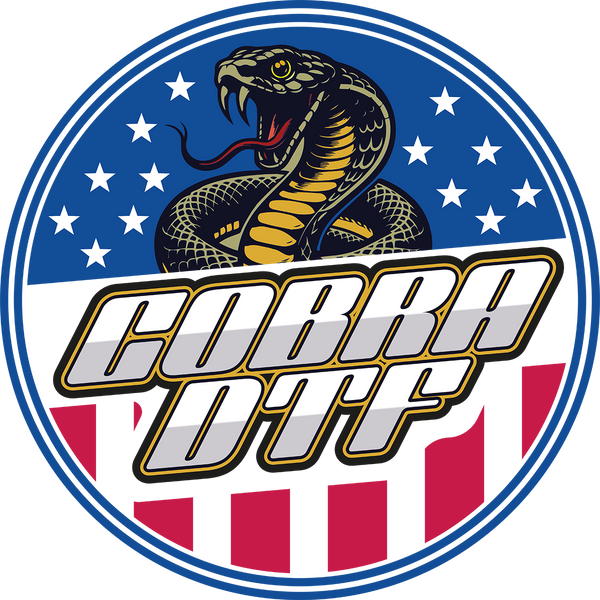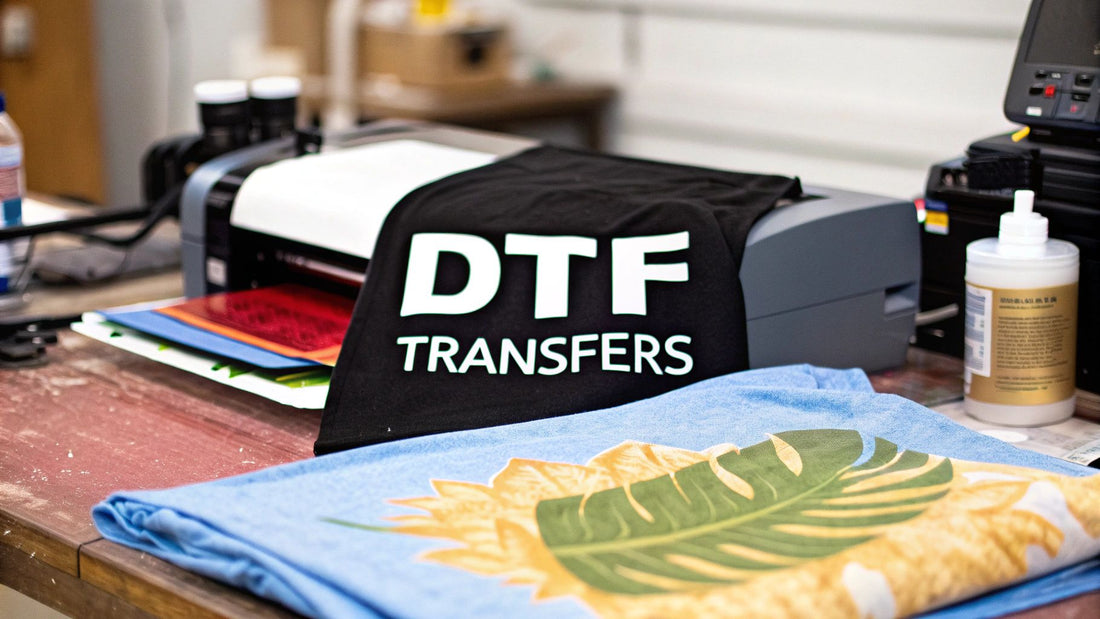
What Is DTF Transfers and How Does It Work
Share
So, what exactly is a Direct-to-Film (DTF) transfer? Let's cut through the noise. Think of it as a high-quality, ready-to-press graphic for fabric. The process is pretty ingenious: you print a design onto a special transfer film, cover it with a powdered adhesive, and then use a heat press to transfer it onto almost any garment.
The result is a vibrant, durable graphic that feels surprisingly soft and flexible to the touch.
Your First Look at DTF Transfers
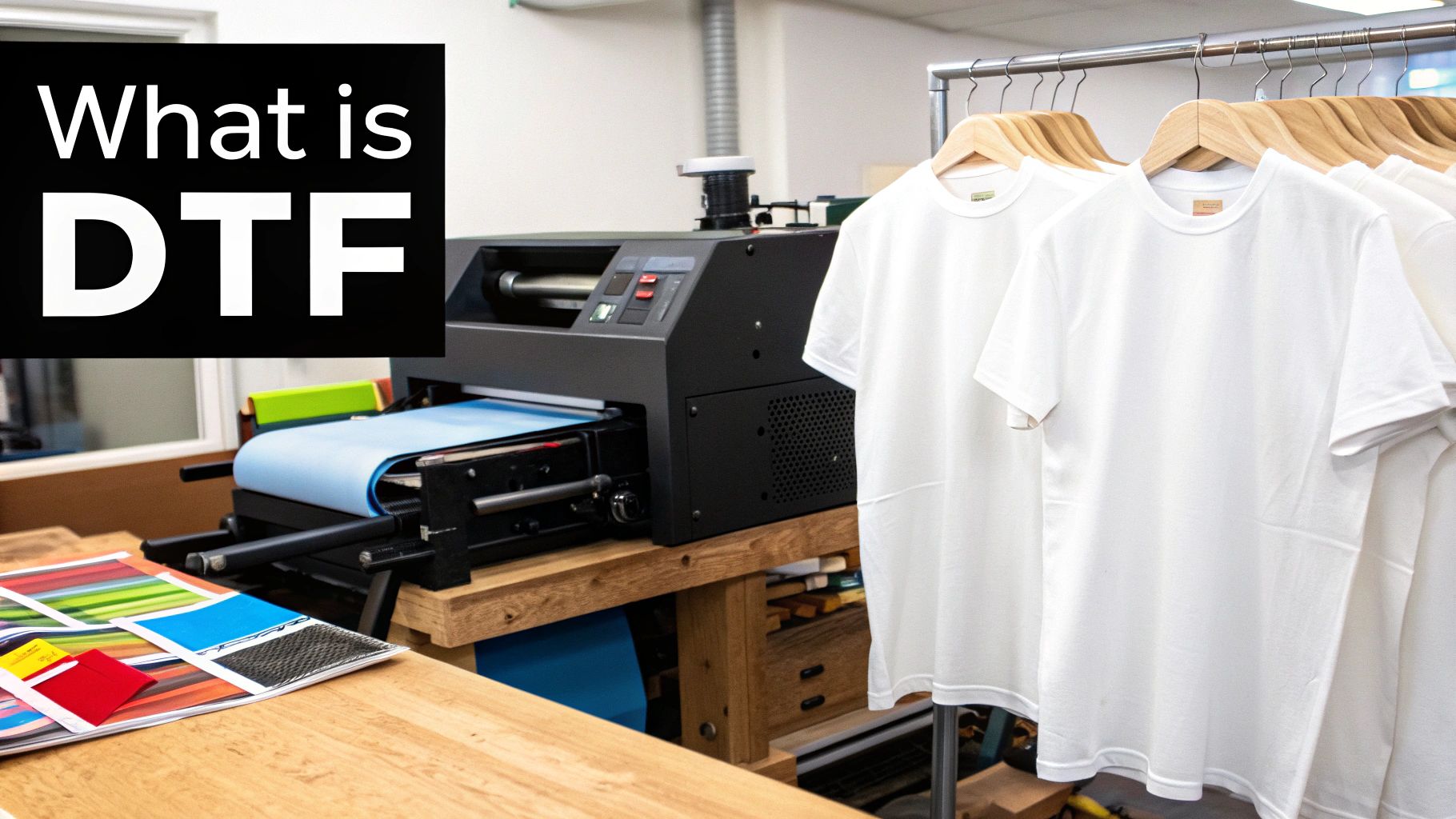
Imagine being able to create a sticker with the stunning detail of a photograph but the rugged durability of a screen print. That’s the essence of a DTF transfer. Instead of printing ink directly onto a garment, which can be tricky, you print onto a carrier sheet—the "film." This film acts as the perfect temporary home for your design before it makes its way onto the final product.
This game-changing method first appeared in the early 2000s, quickly becoming a go-to alternative to older, more cumbersome techniques. You can find more on the history of this printing technique online, but the core idea is simple: it uses a special polyethylene terephthalate (PET) film, specific water-based inks, and a unique adhesive powder that bonds the design to the fabric permanently when heat is applied.
To give you a quick snapshot of the key characteristics, here's a table that breaks down the essentials of DTF transfers. It’s a great way to get a clear overview before we dive deeper into the process.
DTF Transfer Quick Facts
| Characteristic | Description |
|---|---|
| Print Method | Digital printing onto a special PET film, then heat-transferred. |
| Material Compatibility | Works on a massive range of fabrics: cotton, polyester, blends, leather, nylon, and more. |
| Color Capability | Full-color spectrum, including gradients, photorealistic images, and brilliant whites. |
| Feel on Fabric | Soft, flexible, and lightweight with a smooth finish that stretches with the garment. |
| Durability | Excellent. Resists cracking, peeling, and fading for 50+ washes when applied correctly. |
| Best For | Small to medium-sized runs, on-demand printing, and highly detailed or multi-color designs. |
This table highlights just how versatile and reliable the technology is. Now, let's look at the individual components that make it all happen.
The Key Components of DTF
To really get a feel for how DTF works, it helps to understand the main players involved. Each component has a specific job in turning a digital file into a piece of wearable art.
- The DTF Film: This isn't your average plastic sheet. It’s a specially coated film engineered to hold the ink in crisp detail and then release it cleanly under heat.
- Specialized DTF Inks: These are vibrant, water-based pigment inks designed for flexibility. The secret weapon is a brilliant white ink layer that acts as a base, making colors pop on any fabric, light or dark.
- Adhesive Powder: This is where the magic happens. This fine polymer powder is sprinkled over the wet ink. When heated, it melts and acts as the glue, creating a powerful, wash-resistant bond between the ink and the fabric.
- Heat Press: This is the final step. A good heat press provides the consistent temperature and even pressure needed to permanently fuse the design from the film onto the garment.
The beauty of DTF is how these components work together so seamlessly to produce professional-grade results. It gives everyone from home-based creators to large apparel businesses the power to create detailed, full-color designs without the messy, complex setup of traditional printing methods.
How a DTF Transfer Comes to Life
So, how does a design get from a digital file to a vibrant, soft print on a t-shirt? The DTF process is actually pretty clever and breaks down into a few key steps. Think of it as creating a high-tech, super-durable sticker that you then permanently bond to the fabric.
It all starts with a special printer and a unique sheet of PET film. Instead of printing directly on the garment, the printer lays down your design onto this film, but with a twist—it prints it in reverse. The vibrant colors go down first, followed immediately by a layer of bright white ink on top.
This white layer is the secret sauce. It acts as a solid base, making sure your design’s colors pop with full intensity, whether you're putting it on a pitch-black hoodie or a crisp white tee.
Adding the "Glue" with Adhesive Powder
With the ink still wet on the film, the next step is to introduce the DTF adhesive powder. This isn't just any powder; it's a finely milled polymer that's going to act as the permanent bond between the ink and the fabric.
The powdered film is then evenly coated, and the adhesive granules stick only to the wet ink. Any excess is shaken off, leaving a perfectly shaped layer of adhesive right where your design is. To get it ready for pressing, the film is cured with heat, which melts the powder into a smooth, solid sheet over the ink.
The infographic below gives a great visual of how these elements—the film, the ink, and the powder—work together to create the finished transfer, ready for the heat press.
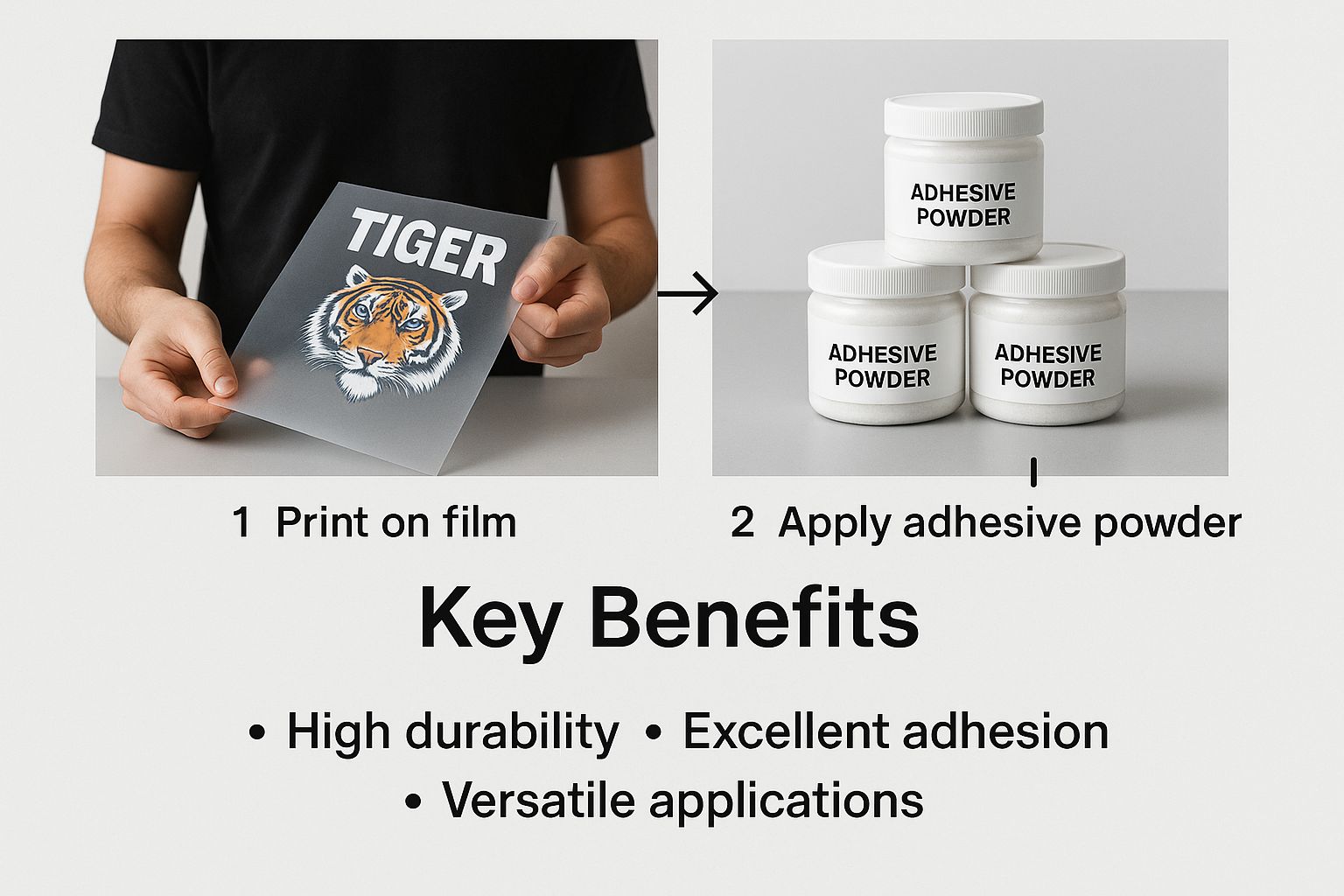
As you can see, it's a simple but effective system that results in an incredibly versatile and wash-resistant final product.
The Final Press and Peel
Now for the magic. The finished transfer sheet is placed onto the garment exactly where you want the design. A heat press then applies even heat and pressure for around 15 seconds. This heat is what reactivates the adhesive layer, causing the ink to fuse directly into the fibers of the fabric.
Pro Tip: The best part of the whole process is the "peel." Once the press is done, you simply peel away the PET film, and it leaves behind nothing but the brilliant, soft, and unbelievably tough design on the garment. The film has done its job.
The whole thing is remarkably efficient. There's no tedious weeding like with vinyl, and none of the messy setup of traditional screen printing.
And for those who want the amazing results without managing the printing and powdering steps, you can find out more about ordering custom DTF transfers ready to press. They show up at your door ready for that final, simple heat press stage. It’s this straightforward process that makes DTF such an amazing tool for everyone from hobbyists to full-scale apparel businesses.
Why Creators and Businesses Choose DTF
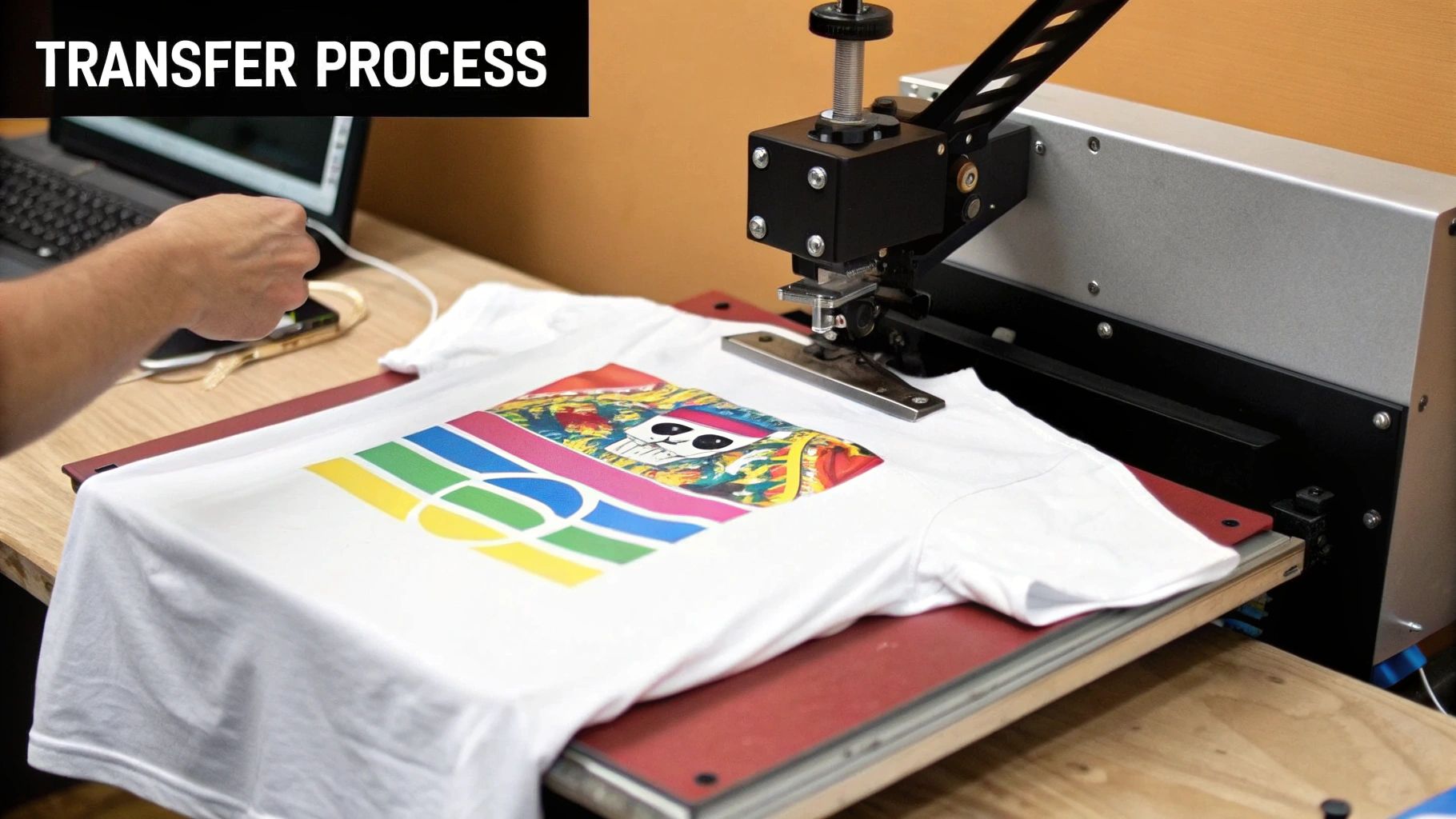
So, why is everyone from independent Etsy sellers to big-name apparel brands getting so excited about DTF? It’s not just one thing. It's the powerful blend of flexibility, eye-popping quality, and sheer efficiency that makes it such a compelling choice.
The biggest win here is its incredible material versatility. Many printing methods are notoriously picky about fabrics, but DTF plays well with almost everything.
This throws the door wide open for creativity. You aren't stuck with just cotton tees anymore. Think polyester activewear, rugged canvas bags, denim jackets, and even tricky items like nylon windbreakers or leather patches. This kind of flexibility means you can offer a much wider variety of products to your customers, all using the same printing setup.
Unmatched Print Quality and Detail
Another huge draw is the absolutely stunning print quality. DTF is a champion at recreating intricate, photorealistic images and complex graphics with a full spectrum of colors. Since the design is printed onto the film first, it captures every fine line, tiny bit of text, and subtle color gradient that other methods often miss.
The magic ingredient is the opaque white ink layer that goes down first. This underbase makes colors pop with the same intensity on a dark black hoodie as they do on a crisp white shirt. No more sad, muted colors on dark garments.
For artists and designers whose work depends on vibrant, detailed graphics, this is a game-changer. DTF respects the original artwork, giving you a final product that looks sharp, professional, and exactly like the design on your screen.
Durability That Lasts
A beautiful design is worthless if it cracks and fades after a few trips through the laundry. This is where DTF really proves its worth, delivering durability that can go toe-to-toe with traditional screen printing.
When a DTF transfer is pressed correctly, the ink literally bonds with the fibers of the fabric. The result is a finish that’s soft, flexible, and built to handle the demands of everyday life.
- Stretchability: The print moves with the fabric without cracking, which is essential for athletic wear or fitted clothing.
- Wash Resistance: A quality DTF transfer can handle 50+ wash cycles without any major fading or breakdown.
- Feel: The final print has a smooth, lightweight feel—a welcome change from the often thick and heavy feel of older heat transfer methods.
This kind of reliability gives you confidence that your products will stay looking great for a long time. That means happier customers, better reviews, and a stronger brand. When someone asks, "what is DTF transfers," the answer always includes its incredible staying power.
Comparing DTF with Other Printing Methods
So, you know what DTF transfers are. But how do they actually stack up against the tried-and-true methods that have dominated custom apparel for years? Seeing DTF in a head-to-head comparison with Direct-to-Garment (DTG), screen printing, and Heat Transfer Vinyl (HTV) is where you can really appreciate what makes it special.
Think of this less as a battle to find the single "best" method and more like picking the right tool for the job. We'll break down the factors that really matter: what fabrics you can print on, how the final print feels, how long it lasts, and which method makes the most sense for your budget and order size.
DTF vs Direct to Garment (DTG)
On the surface, DTF and DTG look like two sides of the same coin. They’re both digital, which means they excel at printing complex, full-color designs without a complicated setup. But the real difference is how the ink gets onto the shirt. DTG prints directly into the fabric's fibers, while DTF prints onto a transfer film first, which is then heat-pressed onto the garment.
That one distinction changes everything. DTG is notoriously picky, working best on 100% cotton that has been carefully pre-treated. DTF, with its "print first, press later" workflow, isn't nearly as fussy. It happily adheres to cotton, polyester, blends, nylon, and even hard goods like wood or metal.
The industry is taking notice, too. Many print shops are making the switch from DTG to DTF because it’s faster and more durable. Some have clocked DTF as being up to 30% faster than a comparable DTG workflow. Plus, its prints hold up beautifully, often lasting over 50 industrial washes without cracking or fading. For a closer look, our detailed guide comparing DTF vs DTG printing methods breaks it all down.
DTF vs Screen Printing
When it comes to massive orders, screen printing is still the reigning champion. The process of pushing ink through a mesh screen is incredibly efficient and cost-effective for large runs of simple designs with just a few colors. Nothing beats it for a 1,000-shirt order of a one-color logo.
But screen printing's greatest strength is also its biggest hurdle. The setup is a major undertaking. You have to create a separate screen for every single color in your design, which is both time-consuming and expensive. This makes it a non-starter for small orders, one-offs, or photorealistic images with subtle gradients and tons of colors.
This is exactly where DTF comes in. With no color limitations and zero setup costs per design, you can print a single shirt with a full-spectrum photograph just as easily as you can print 50. It’s perfect for on-demand jobs and small-to-medium batches that would be financially impossible with screen printing.
DTF vs Heat Transfer Vinyl (HTV)
Heat Transfer Vinyl is the go-to for many crafters and small shops. You cut a design from a sheet of colored vinyl and press it onto a shirt—it’s great for personalizing jerseys with names and numbers or creating bold, simple graphics.
The catch? The dreaded "weeding." That’s the painstaking process of using a sharp tool to pick away all the excess vinyl around your design. For a simple shape, it’s no big deal. But for an intricate piece of artwork with fine details? It's a recipe for a headache and a huge time sink.
DTF completely sidesteps this problem. Since the adhesive powder only sticks to the printed ink, you get a perfect, full-color transfer every time. You can create incredibly detailed, complex images with no weeding, period. It's a massive time-saver that opens up a whole new world of design possibilities.
DTF vs DTG vs Screen Printing vs HTV
To really see where each method shines, let's put them side-by-side. This table breaks down the key differences to help you decide which printing technique is the best fit for your next project.
| Feature | DTF | DTG | Screen Printing | HTV |
|---|---|---|---|---|
| Best For | On-demand prints, small-to-medium runs, full-color designs on any fabric. | High-detail, full-color designs on 100% cotton garments. | High-volume orders (100+) with simple designs (1-4 colors). | Simple text, numbers, and basic logos on any fabric. |
| Material Compatibility | Excellent. Cotton, polyester, blends, nylon, leather, wood. | Limited. Best on 100% cotton; some blends with pre-treatment. | Good. Works on most fabrics but ink may vary by material. | Excellent. Works on a wide variety of fabrics and materials. |
| Feel of Print | Soft, smooth, and flexible. Sits on top of the fabric. | Very soft and breathable. Ink soaks into the fabric fibers. | Can be heavy, depending on ink layers. Sits on top of the fabric. | Thicker, often feels like a plastic layer on top of the fabric. |
| Color & Detail | Unlimited colors and gradients. Excellent for photorealistic images. | Unlimited colors and gradients. Great for photos, but no white ink on darks. | Limited. Each color requires a new screen, increasing costs. | Limited to available vinyl colors. Layering is complex. |
| Durability | Excellent. Can withstand 50+ washes without cracking or fading. | Good, but can fade over time with washing, especially on darks. | Excellent. Very durable and long-lasting; an industry standard. | Good. Can crack or peel over time, especially if not applied correctly. |
| Setup Time & Cost | Low. No setup per design; print on demand. | Low. No setup per design; direct from digital file. | High. Screens must be created and set up for each color. | Medium. Depends on weeding complexity. |
Ultimately, there's a place for every method. HTV is great for a quick one-off jersey, and screen printing is the only logical choice for a 5,000-piece event order. But for the vast majority of modern apparel decoration needs—from small business merch to complex, custom orders—DTF offers an unbeatable combination of versatility, quality, and efficiency.
Creative Ideas and Applications for DTF
If you think DTF transfers are just for slapping a logo on a cotton t-shirt, you're missing out on where the real magic happens. This technology's true strength is its incredible versatility, letting you break free from basic apparel and explore all sorts of profitable niches.
The secret is in the adhesive. It's formulated to bond with a huge range of materials, which means you're no longer boxed in by fabric type. You can create a whole line of branded products, all using the exact same transfers.
Beyond the Basic Tee
DTF lets you print on all the tricky items that other methods, especially DTG, just can't handle. That flexibility is a game-changer for anyone wanting to offer something more than the competition.
Let's look at a few real-world examples to get the gears turning:
- Headwear: Think detailed, multi-color logos on baseball caps, beanies, and bucket hats. It doesn't matter if they're cotton, polyester, or a blend—DTF handles them all.
- Bags and Accessories: You can easily create custom tote bags, canvas backpacks, or even small makeup pouches with sharp, durable designs that won't peel or crack.
- Tough-to-Print Apparel: DTF is perfect for decorating rugged gear like denim jackets, workwear, and nylon windbreakers. The print holds up beautifully without sacrificing quality.
- Footwear: Ever wanted to personalize canvas sneakers? You can press small, detailed logos or vibrant graphics onto the side panels for a completely custom look.
Being able to decorate such a wide variety of goods means you can serve very specific communities—from sports teams needing a full set of branded gear to artists who want to see their work on more than just a standard tee.
Expanding Your Product Line
One of the best parts of working with DTF is how easily you can grow your product catalog without buying a bunch of new, specialized equipment. The very same transfer that works on a t-shirt can just as easily be applied to a hoodie, a tote bag, or a pair of jeans.
This is a huge advantage. It lets you test out new product ideas with small runs, jump on trends the moment they hit, and offer bundled product packages with perfectly consistent branding. Imagine selling a matching hat, shirt, and tote bag combo, all decorated with the same stunning DTF print.
At the end of the day, understanding what DTF transfers are all about means seeing them as more than just a printing technique. They're a tool for creative freedom and a direct path to growing your business by turning everyday items into premium, personalized products people are excited to own.
The Future of Custom Printing Is Film
Direct-to-Film isn't just another method on the list; it’s a genuine sea change in how we create custom goods. We're seeing this technology take off because it hits the sweet spot of modern demand: personalization, speed, and cost-effectiveness. For anyone starting a new venture or running a small business, the relatively low startup cost smashes a huge barrier that traditional printing methods put up.
At the same time, customers want unique items, and they want them now. DTF is perfectly built for this reality, making small, full-color print runs not just possible, but profitable. It's this perfect match with what the market wants that’s driving its incredible growth.
What Is Driving DTF Forward
This isn't just a gut feeling; the numbers back it up. The global market for Direct-to-Film printing is booming, mostly because of the worldwide appetite for custom apparel. In fact, market research suggests the industry is set to grow at a compound annual rate of about 6.2% between 2021 and 2028. This rapid expansion is happening in both established print shops and new businesses, as outlined in this analysis of the global DTF printing market.
DTF’s real magic lies in its ability to bring professional-grade printing to everyone. It gives creators the power to produce durable, brilliant, and intricate designs without the massive investment older technologies demanded.
And it’s not slowing down. The pipeline for innovation is packed. We’re already seeing faster printers that will crank up production efficiency, and new, more eco-friendly inks and powders are on the horizon. Automation is also starting to creep in, simplifying everything from preparing the digital file to the final press.
These constant improvements are cementing DTF's place as a major player in the industry. While DTF is the star of the show for textiles, a similar technology is doing amazing things for hard goods. You can dive deeper into that process in our guide to UV DTF printing. As these film-based methods keep getting better, they're going to keep unlocking new creative and business opportunities for a long time to come.
Your DTF Questions, Answered
Alright, so you get the theory behind DTF, but what about the practical stuff? When you're about to press that first shirt, the real-world questions always pop up. Let's walk through some of the most common things people ask, so you can start your project with confidence.
One of the first things everyone wants to know is, what does a DTF print actually feel like on a shirt? Forget that thick, plastic-y feel you get from some heat vinyl. A good DTF transfer is surprisingly soft and pliable. It has a smooth finish that almost becomes one with the fabric, so it can stretch and move without cracking. This makes it perfect for comfy, everyday clothes that people will actually want to wear.
Then there's the big one: durability. How long is this thing really going to last? A high-quality DTF transfer is tough. When you press it correctly, the design can easily handle 50 or more washes without the colors fading or the print starting to peel or crack. That's right up there with traditional screen printing, meaning your designs will look great for a long time.
Nailing the Application and Care
To get that kind of longevity, a little bit of care goes a long way. So, what's the secret to washing a DTF-printed garment? Keep it simple.
- Flip it inside out. This is the easiest way to protect the print from rubbing against other clothes in the wash.
- Use cold water on a gentle cycle.
- Tumble dry on low heat. If you really want to baby it, hang it up to dry.
- Steer clear of bleach and other harsh detergents. They can degrade the ink and adhesive over time.
Following these basic rules will keep your prints looking sharp, wash after wash.
A question I hear all the time is, "Why isn't my transfer sticking right?" In my experience, this problem almost always boils down to three things: heat, pressure, or time. Double-check that your heat press is at the right temperature, make sure you're applying firm and even pressure across the whole design, and press it for the full recommended time.
What Can You Really Print On?
While DTF is a workhorse, it can't do everything. It's fantastic on cotton, polyester, all sorts of blends, canvas, and even denim. The limitation really comes down to heat. If a material can't handle the heat from a press—think delicate synthetics or fabrics with special heat-sensitive coatings—then DTF isn't the right choice.
Finally, people often wonder if they can just use their regular office printer. The answer is no. DTF printing requires a dedicated setup: a special inkjet printer that's been modified to use DTF inks (including that crucial white ink) and can print onto the transfer film. This specialized equipment is what makes the magic happen, turning a digital file into a piece of professional-quality wearable art. Getting a handle on these practical details helps you see what DTF transfers can really bring to the table for your projects.
Ready to create vibrant, durable custom apparel without the hassle? Cobra DTF offers premium, USA-made DTF transfers that are ready to press, shipped the same day, and delivered in 1-3 days. Explore our high-quality transfers and see the difference for yourself.
